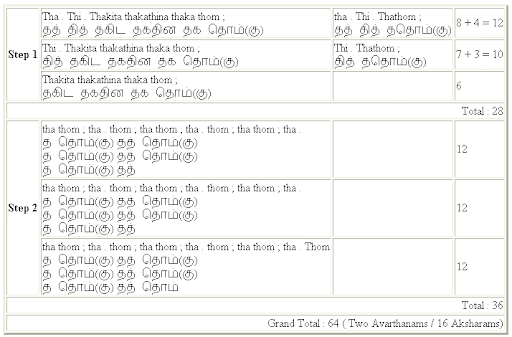The first round of thaniavarthanam looks like net practice - warming up for a big one. After playing 4 syallables in chatursram, mani sir takes 24 (12 in fast tempo) mathrai syllable for a small korvai. You cant call this as a korvai, we can call this as abhiprayam. I have seen many people calling this as a korvai and many people calling this as Abhiprayam (Abhiprayam differs ;-)).
Though the abhiprayam looks simple its a bit confusing. The abhiprayam is constructed in the following way. First lets see the structure and then the abhiprayam as syllables.
Part 1 :
Step 1 : First syllable for 3 Aksharams - 12 Matharis ( splitted as 8 and 4 )
Step 2 : Second Syllable for 2.5 Aksharams - 10 Mathrais ( splitted as 7 and 3 )
Step 3 : Third Syllable for 1.5 Aksharams – 6 Mathrais.
Total comes to 28 Mathrais or 7 Aksharams. (Since its chatursram, a beat consists of 4 mathrais, it comes to 7 Aksharams)
Part 2:
A balance of 36 matharis or 9 aksharams is pending. Now this 9 is divided into 3 parts. A 3 akshram syllable is taken as arithi which constitutes this Abhiprayam.

Harishankar started of few fast phased syllables and played a simple abhiprayam for 3 Avarthanams. The structure of the Abhiprayam is very simple, but a simple change made it sounds better.
The strucutre needs no diagrams a its a straigh forward abhiprayam, if you dont understand I will give more details on this.
6 3 , 6 3, 6 3 - 27
8 3 , 8 3 ,8 3 - 33
10 3, 10 3, 10 - 36
the total comes to 96. which comes for 3 Avarthanams. Six can be played as Thatheekitathom, 8 as thaka Thatheekitathom and 10 as thakathina Thatheekitathom.
2 comments:
Nice breakdown. I think it is important to point out a few additional things:
1) Development. First there is warm-up with a few simple and common sollus. Then, starting from about 38 seconds, Mani sir's sollus are all built on the common pattern that is used to build this abhiprayam (korvai), namely the "thakathina thaka thom ;". Then the abhiprayam is played.
2) To make the pattern clear, the last component of Step 1 should have an extra "thathom ;", making it 8 mathrais. Then the reduction pattern is crystal clear. This last "thathom ;" of Step 1 is then the SAME "thathom ;" that begins Step 2. In this way, the two pieces actually overlap, with the end of one beginning the next. The principle of overlap is used all over the place in korvai composition so it's important to point it out.
In other notations I have seen a comma is equal to 1 karvai. It took me a while to figure out how to make your GH korvai come to samam. Thanks all the same - great blog!
Post a Comment